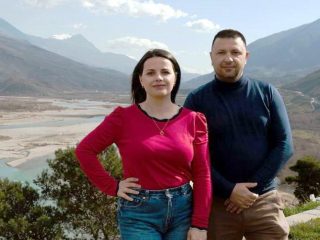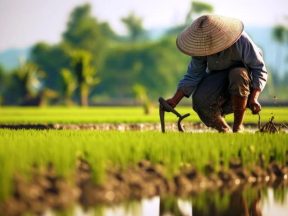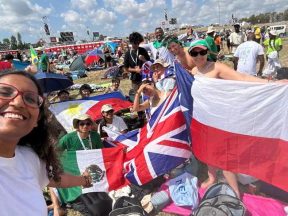The Fox, the Monkey, the Hare and the Horse.
The fox is the wicked animal in the forest, and everyone hates him. He is for ever cheating people and playing tricks on everyone. There is not a single animal in the whole neighbourhood who has not been fooled by him, but for a long time no one could think of a way
to get their revenge.
One day a monkey in the forest seated himself on a tree and thought and thought. He thought so hard that his forehead became a mass of wrinkles. Finally he thought of a plan. Bursting with it, he turned a somersault down to the ground to tell the hare, who lived in a grass-lined form under the tree. He told her his idea, but the hare only blinked in distrust. “Come on,” said the monkey, “I’ll show you. I’ll go to the fox and you go to the rise over there and watch.”
When the monkey found the fox, they got into conversation. “Brother Fox!” he said. “Do you know what is the best food in the world?” The fox pricked up his ears at the idea of food. “What is it?” he said eagerly. “The best food in the world! Now that is a very interesting question! Tell me!”
“I’ve only learned about it today,” answered the monkey. “It is the flesh on the rump of a horse. The only difficulty is to get hold of it, and to do that you must fasten your tail tightly to the horse’s tail.” “Why do you have to do that?” said the fox, rather worried.
“You have to, and you have to tie it very tight,” answered the monkey. “Otherwise, when the horse starts to run, you can’t keep up with him!”
The monkey dropped his voice and came closer.
“I can tell you, as I was coming along I saw the horse lying down, fast asleep. Now’s your chance!”
The fox listened with great interest to what the monkey had to say but showed no emotion. “I’ll think about it,” he said quietly. “A thing like the best food in the world needs a lot of consideration. We must meet again later and have another chat. For the time being, you’d better not tell anybody about it, don’t you think?” He flourished his long tail and strolled off. The monkey also departed. The fox only went a little way, until he saw the monkey had disappeared, then he quietly returned to look for the horse which the monkey had mentioned.
He did not take long to find the horse, lying on his side fast asleep after his day’s work, as the monkey had said. The fox crept over and stealthily tied his tail to the horse’s tail. Then he took a good bite at the horse’s rump. The horse woke up in a terrible fright; he jumped up, not knowing what was happening and galloped off, never looking round.
Of course the fox’s grip with his jaw was loosened and he was dragged along on his back, with his tail still tightly fastened to the horse. “Oh!” he yelled. “How painful this is!”
He was very unhappy, and did not know which part he should try to protect first, his flesh, his skin, or his pretty tail.
The monkey had not gone far. He had just climbed up a tree to watch. He was so amused by the comic scene as the fox was being pulled along by the horse that he clapped his hands and jumped, missed his footing and fell down smack on his bottom, making it all red. The hare, watching from the rise, laughed so much that she split her lip.
That is why up to the present the monkey’s bottom is always red; the hare has a split upper lip; the horse is afraid to lie down to sleep and lies down only for a short time when he is very tired, and the fox’s back is always marked with spots and blemishes.
Folktale from Han People. China








